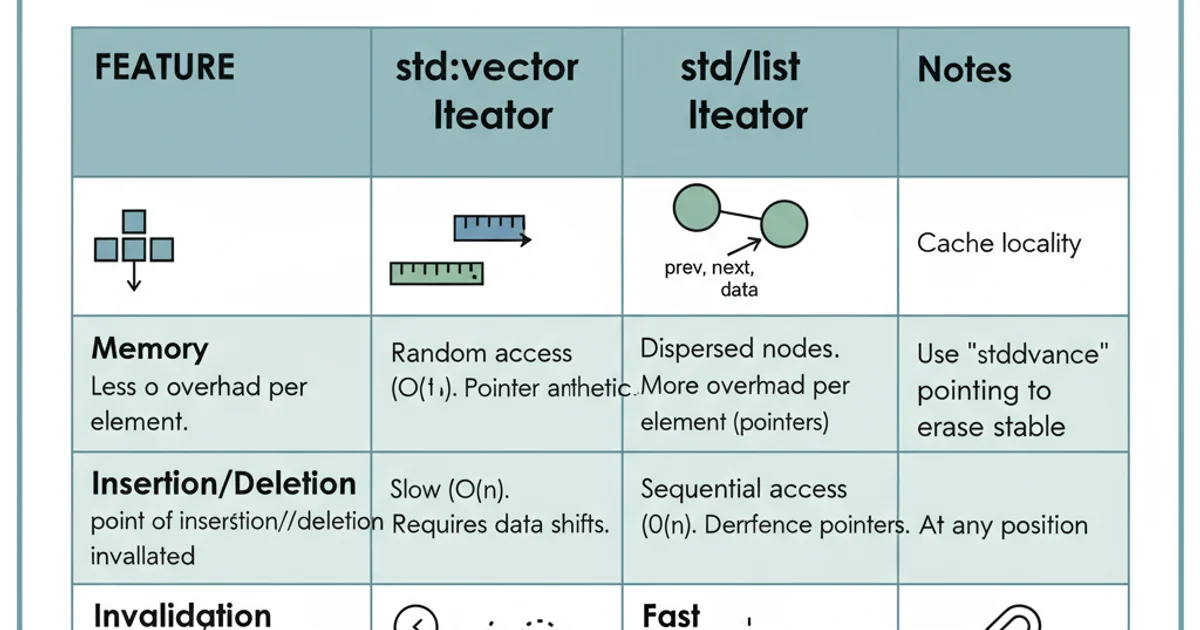List iterator vs. vector iterator
Categories:
C++ Iterators: std::list vs. std::vector

Explore the fundamental differences between iterators for std::list and std::vector in C++, understanding their performance implications and use cases.
In C++, iterators are a powerful concept that provides a uniform way to access elements in various container types. While they offer a common interface, the underlying implementation and behavior of iterators can differ significantly based on the container. This article delves into the distinctions between iterators for std::list and std::vector, two of the most commonly used containers in the Standard Template Library (STL). Understanding these differences is crucial for writing efficient and robust C++ code.
Understanding std::vector Iterators
std::vector is a sequence container that encapsulates dynamic size arrays. Its elements are stored in contiguous memory locations, similar to a raw C-style array. This contiguous storage is the key characteristic that defines the behavior of std::vector iterators.
graph TD
A[std::vector] --> B[Contiguous Memory]
B --> C[Random Access Iterators]
C --> D["O(1) Element Access"]
C --> E["O(N) Insert/Delete (Middle)"]
D --> F["Pointer-like Behavior"]
E --> G["Invalidation on Resize/Insert/Delete"]Characteristics of std::vector and its iterators.
Because std::vector elements are stored contiguously, its iterators are random access iterators. This means you can perform arithmetic operations on them (e.g., it + 5, it - 2) and directly jump to any element in constant time, just like with pointers. This makes std::vector ideal for scenarios requiring fast random access to elements.
#include <vector>
#include <iostream>
int main() {
std::vector<int> vec = {10, 20, 30, 40, 50};
// Random access using iterator arithmetic
auto it = vec.begin();
std::cout << "First element: " << *it << std::endl; // 10
it += 2; // Move 2 positions forward
std::cout << "Element after moving 2 positions: " << *it << std::endl; // 30
// Direct access using operator[]
std::cout << "Element at index 3: " << vec[3] << std::endl; // 40
return 0;
}
Demonstrating random access with std::vector iterators.
std::vector iterators is their invalidation. Operations like push_back (if it causes reallocation), insert, or erase can invalidate existing iterators and references to elements. This is because these operations might reallocate the vector's memory or shift elements, making previous iterator positions incorrect.Understanding std::list Iterators
std::list is a sequence container that implements a doubly linked list. Unlike std::vector, its elements are not stored contiguously in memory. Instead, each element is stored in a separate node that contains the element's value and pointers to the previous and next nodes in the sequence.
graph TD
A[std::list] --> B[Non-Contiguous Memory]
B --> C[Bidirectional Iterators]
C --> D["O(N) Element Access (by index)"]
C --> E["O(1) Insert/Delete (Known Position)"]
D --> F["No Pointer Arithmetic"]
E --> G["No Invalidation on Insert/Delete (except deleted element)"]Characteristics of std::list and its iterators.
Due to its linked structure, std::list iterators are bidirectional iterators. This means you can only move them one step at a time, either forward (++it) or backward (--it). You cannot perform arbitrary arithmetic operations like it + 5 because there's no guarantee of contiguous memory. Accessing an element by its index (e.g., the 5th element) requires traversing the list from the beginning, resulting in O(N) time complexity.
#include <list>
#include <iostream>
int main() {
std::list<int> lst = {10, 20, 30, 40, 50};
auto it = lst.begin();
std::cout << "First element: " << *it << std::endl; // 10
// Move forward one by one
++it;
std::cout << "Element after ++it: " << *it << std::endl; // 20
// Move backward one by one
--it;
std::cout << "Element after --it: " << *it << std::endl; // 10
// This would be a compile-time error: it += 2;
return 0;
}
Demonstrating bidirectional access with std::list iterators.
std::list is its efficient insertion and deletion of elements anywhere in the list (O(1) complexity), provided you have an iterator pointing to the insertion/deletion point. Furthermore, std::list iterators are generally more stable; they are not invalidated by insertions or deletions of other elements, only by the deletion of the element they point to.Key Differences and Performance Implications
The fundamental difference in memory layout leads to distinct performance characteristics and use cases for std::vector and std::list iterators.

Comparison of std::vector vs. std::list Iterator Characteristics.
When choosing between std::vector and std::list, consider the following:
- Random Access: If you frequently need to access elements by index or jump around the collection,
std::vectoris superior due to its random access iterators and contiguous memory. - Insertions/Deletions: If you frequently insert or delete elements in the middle of the collection,
std::listis more efficient (O(1)) once you have an iterator to the position.std::vectorcan be O(N) for these operations as it might require shifting many elements. - Iterator Stability: If you need iterators to remain valid across insertions and deletions (of other elements),
std::listis the safer choice.std::vectoriterators are easily invalidated. - Memory Overhead:
std::listtypically has higher memory overhead per element due to storing pointers to the next and previous nodes.
std::vector is often the default choice due to better cache performance and lower memory overhead. std::list shines in specific scenarios requiring frequent middle insertions/deletions and stable iterators.